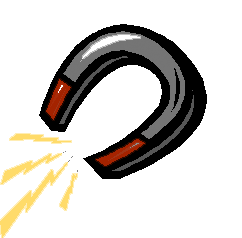EU2.1. Doing Work to Create Electricity

{ Energy Use Contents } { All GSS Books }
Use magnets and coils of wire to investigate what kind of responses you can get from an electric meter. Your challenge is to arrange and rearrange the magnets and wires to generate as much electrical output as you can.
Materials

- magnet wire (24 gauge, 3 meters)
- wire clippers
- sand paper
- iron rods
- magnets
- electric meter (can be galvanometer, volt meter or ammeter)
Preparation
- Cut a length of magnet wire about 3 meters long. Typical electric wire has a plastic insulation that can be stripped off at the ends so that you can make electrical connections. Magnet wire has a lacquer insulation on it that can be removed with sand paper. Fold a small piece of sand paper around one end of the magnet wire. Pinch it firmly with one hand and pull the wire out with the other hand. Repeat this until the shiny pink copper is completely uncovered. Strip about 3 centimeters off both ends of the wire.
- Make a coil with your wire.
Your team must make these decisions:- How many turns of wire will the coil have? You are limited by the length of the wire.
- How large will the coil be? This decision may be influenced by the size and shape of the iron rods and the magnets that are available to you.
- Will you wrap the coil around one or more iron rods, or will your coil have an open core? To make an open-core coil, wrap the wire around your fingers (loosely!), or another object, and then remove the coiled wire.
- Leave at least 20 centimeters of wire at each end of the coil.
3. Connect the ends of the coil to the electric meter. The meter may be a galvanometer, a volt meter, or an ammeter
Strategies for Investigation
- Move the coil and the magnet near each other. Watch the needle on the meter. Movement of the needle indicates that electricity is flowing through the coil. Try different ways of moving the coil to produce as much electricity (movement of the needle) as possible. What happens when the coil stops moving?
- Sketch the arrangement of the coil and the magnet. Note where the poles of the magnet are and indicate how they were moving when the meter responded. If your meter can indicate the direction of the current or whether the voltage was positive or negative, then note how that changed as you moved the magnet and coil.
- Share what worked and what did not work with other groups in your class. Then try to increase the electric output of your system. Decide with your team on one change to make in your coil or a change in the way you moved your coil and magnet. Rebuild your coil and repeat the procedure to see if the meter responds differently. Record your results and make a new sketch of your rebuilt system.
Results
Make a brief report on your generating system that includes all the sketches and meter readings. Make sure your report answers these questions:

- What kind of motions did you make with the coil and the magnet that caused the highest readings on the meter?
- If your meter sometimes gave a positive reading and sometimes a negative reading, that means the current changed the direction it was flowing through the wire. Were you able to control which way the current flowed?
- How did the changes you made in the system during the experiment affect the electric output?
- Recall the definition of energy, where can you find energy in the system consisting of you, the coil of wire, the meter, and the magnet?

